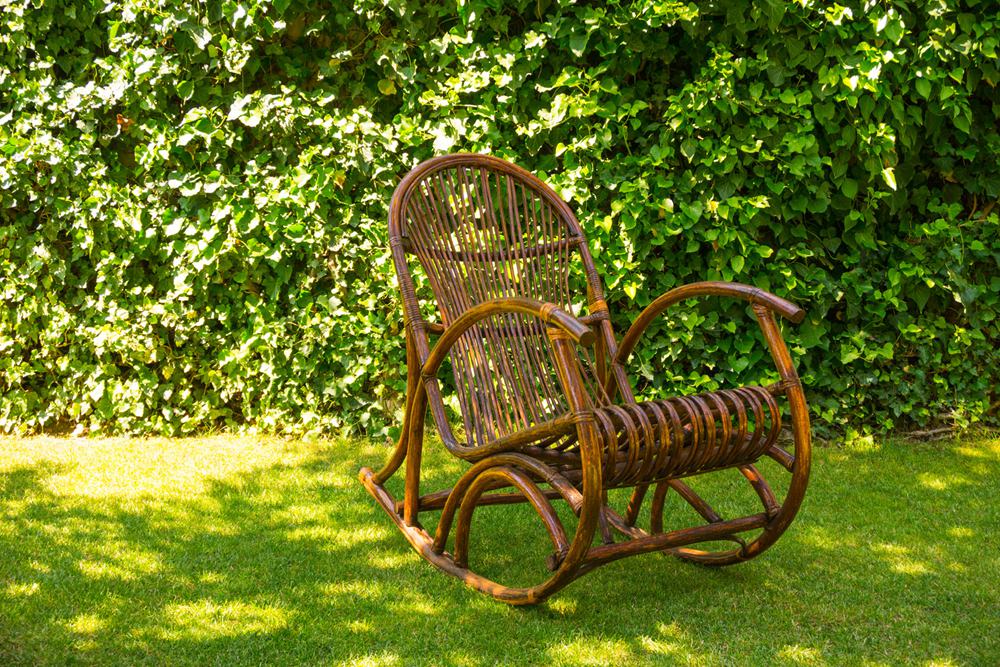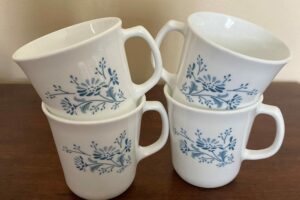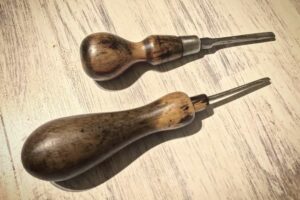Antique rocking chairs have a distinct charm and style that can add character and warmth to your home. These treasured pieces often hold stories of the past, with their intricately crafted designs and sturdy materials. In this article, you will learn how to identify and value these historical gems to better appreciate their worth and gain a deeper understanding of their significance in the world of furniture.
When it comes to identifying antique rocking chairs, several factors can come into play. From examining the wood type and surface finishes to detecting production marks and considering their manufacturing process, you will soon become proficient in determining the authenticity and age of your rocking chair. Awareness of upholstery specifications, nails, screws, and joinery features also plays a crucial role in establishing your chair’s history and value.
Having the knowledge to evaluate antique rocking chairs will not only make you a more informed collector or owner, but it will also help you make well-informed decisions when it comes to purchasing or selling such prized possessions. As you delve into the captivating world of antique rocking chairs, you’ll gain a deeper appreciation for their beauty, history, and craftsmanship, enriching your understanding of this timeless piece of furniture.
Table of Contents
History of Antique Rocking Chairs
Colonial American Era
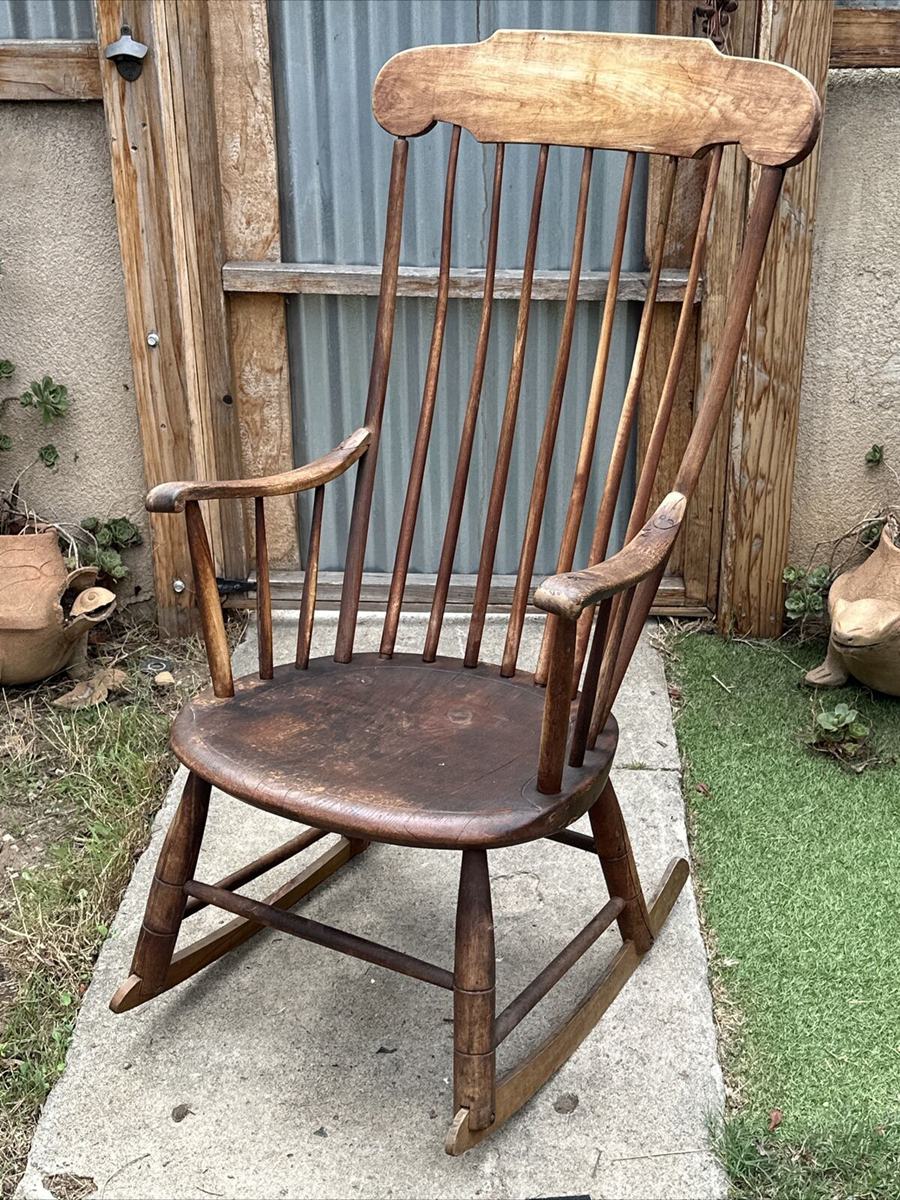
Rocking chairs first entered the market in 1710 in Europe and were originally designed for hospitals to help new mothers calm their babies. These chairs eventually spread to America, with production starting in the 1780s. Throughout the early 1800s, American rocking chairs showcased:
- Lightweight construction
- Straight-lined body
- Low-relief carvings
- Inlaid details
Colonial rocking chairs often featured Roman-inspired designs and were popular in Boston, one of England’s major American colonies.
Windsor Rocking Chairs
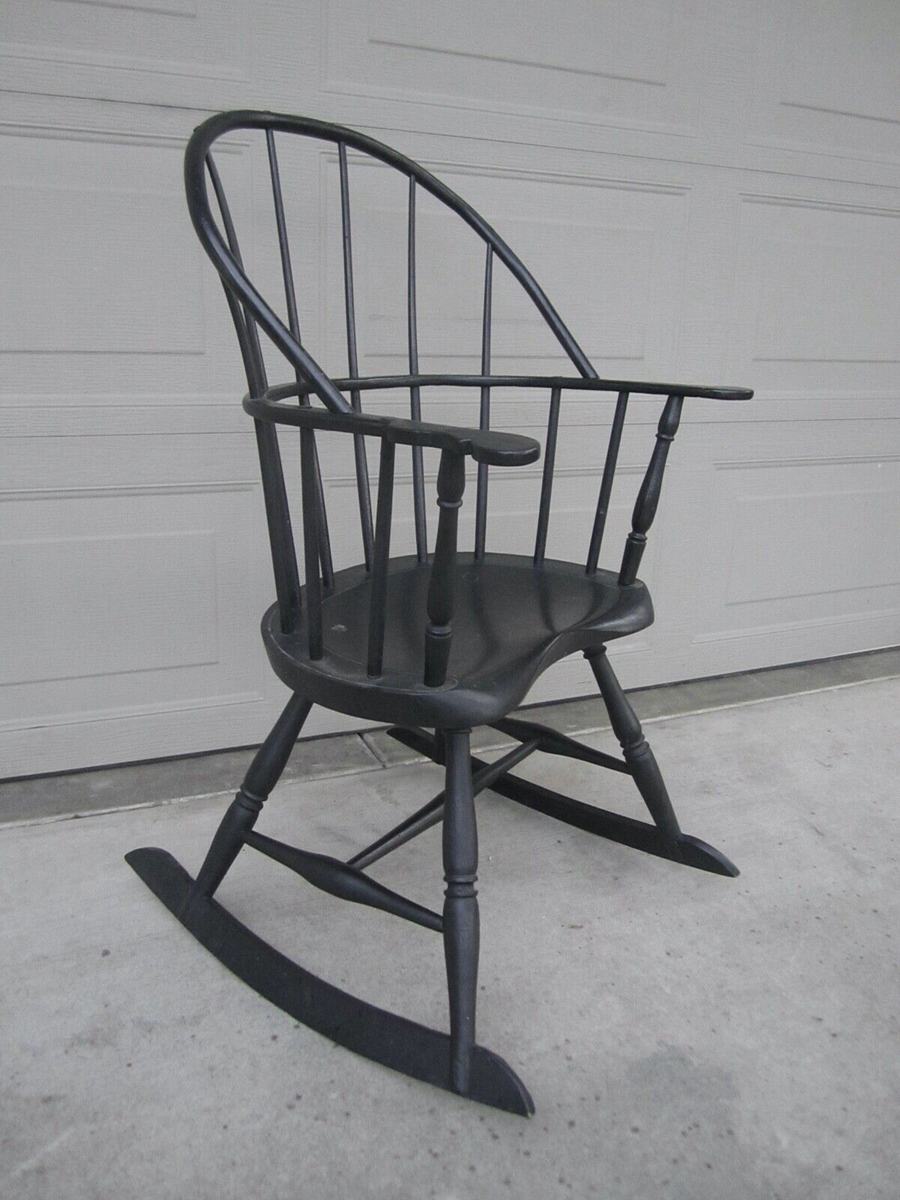
In the 18th century, both Britain and the USA saw the development of ladder-back and Windsor chairs, which had rockers attached to their legs. Windsor rocking chairs were characterized by:
- Spindle backs
- Solid wooden seats
- Bentwood arms
- Splayed legs
These chairs were highly popular in North America, and their design became a timeless classic still sought after today.
Victorian Era

In the late 1800s, Victorian-style rocking chairs gained popularity. This era saw rocking chairs with:
- Carved arms
- Spiral legs
- Curvilinear shapes
These chairs are now valued at about $500 – 800. Later in this period, chairs with pad armrests, slated backs, and thick wood sections emerged, featuring minimal designs but heavy and durable construction.
Arts and Crafts Movement
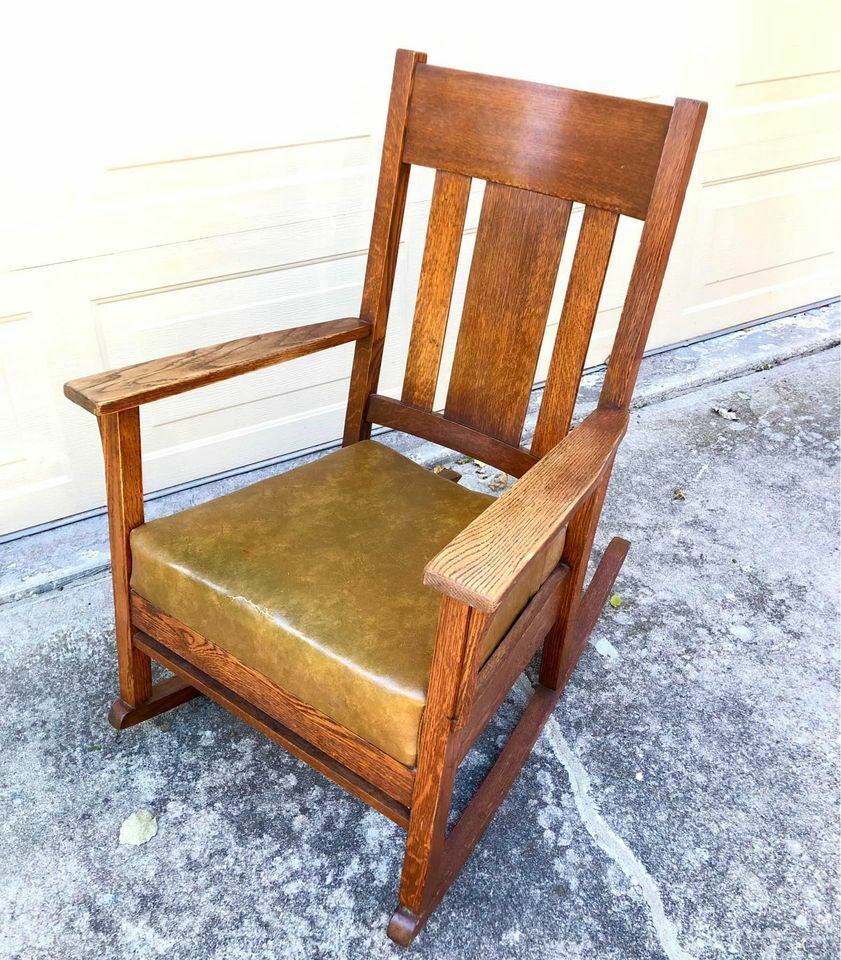
The Arts and Crafts Movement surfaced in the late 19th and early 20th centuries, emphasizing handcrafted items over mass-produced goods. Rocking chairs from this era are typically characterized by:
- Simple, functional designs
- Handcrafted details
- Solid, quality materials
These chairs now showcase the importance of skilled craftsmanship and authenticity in antique furniture, making them highly sought after by collectors.
To effectively identify and value antique rocking chairs, pay close attention to their design elements, construction, and historical context. This knowledge will help you appreciate their uniqueness and determine their worth.
Identifying Different Types of Antique Rocking Chairs
Windsor Rocking Chair

Windsor rocking chairs are distinguished by their spindle backs and rounded, curved seats, which provide added comfort. These chairs typically have a bow-shaped top rail and a continuous armrest that connects to the spindles. To identify a genuine Windsor rocker, look for signs of hand-carving or shaping in the joinery and spindles.
Platform Rocker
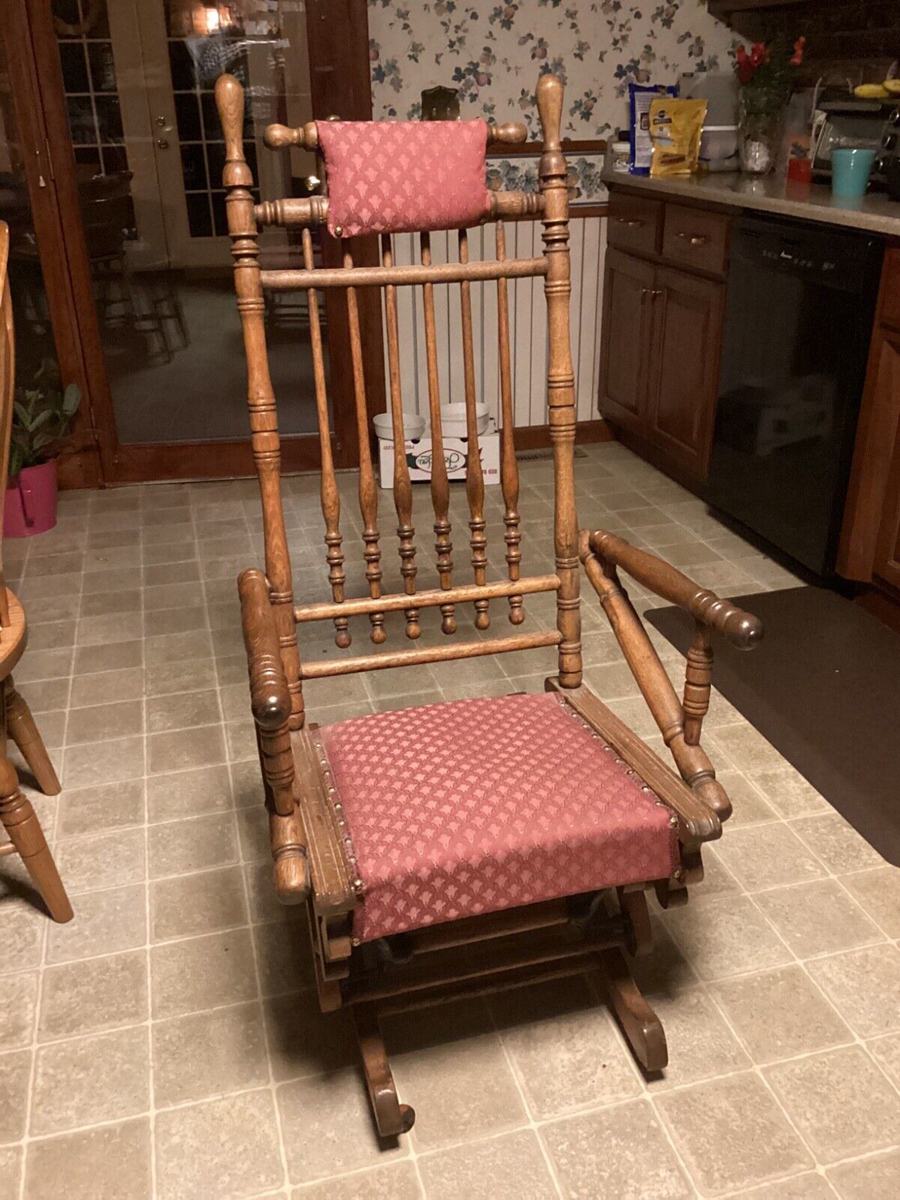
Platform rockers are unique because they sit on a stationary base or platform, rather than directly on the floor. The rocking mechanism is built into the chair itself, allowing for a smoother rocking motion. To identify a platform rocker, check for a sturdy base with springs or other suspension devices, and look for period materials and design features, such as carved wood or scrolled cast iron.
Boston Rocker

Boston rockers are known for their curved backs and painted finishes. They usually have a decorative panel on the headrest and a spindle back. The legs and rocker rails are often curved or carved, adding to their elegant appearance. To identify a Boston rocker, look for these design elements and check for signs of age, such as wear on the paint or varnish.
Shaker Rocking Chair
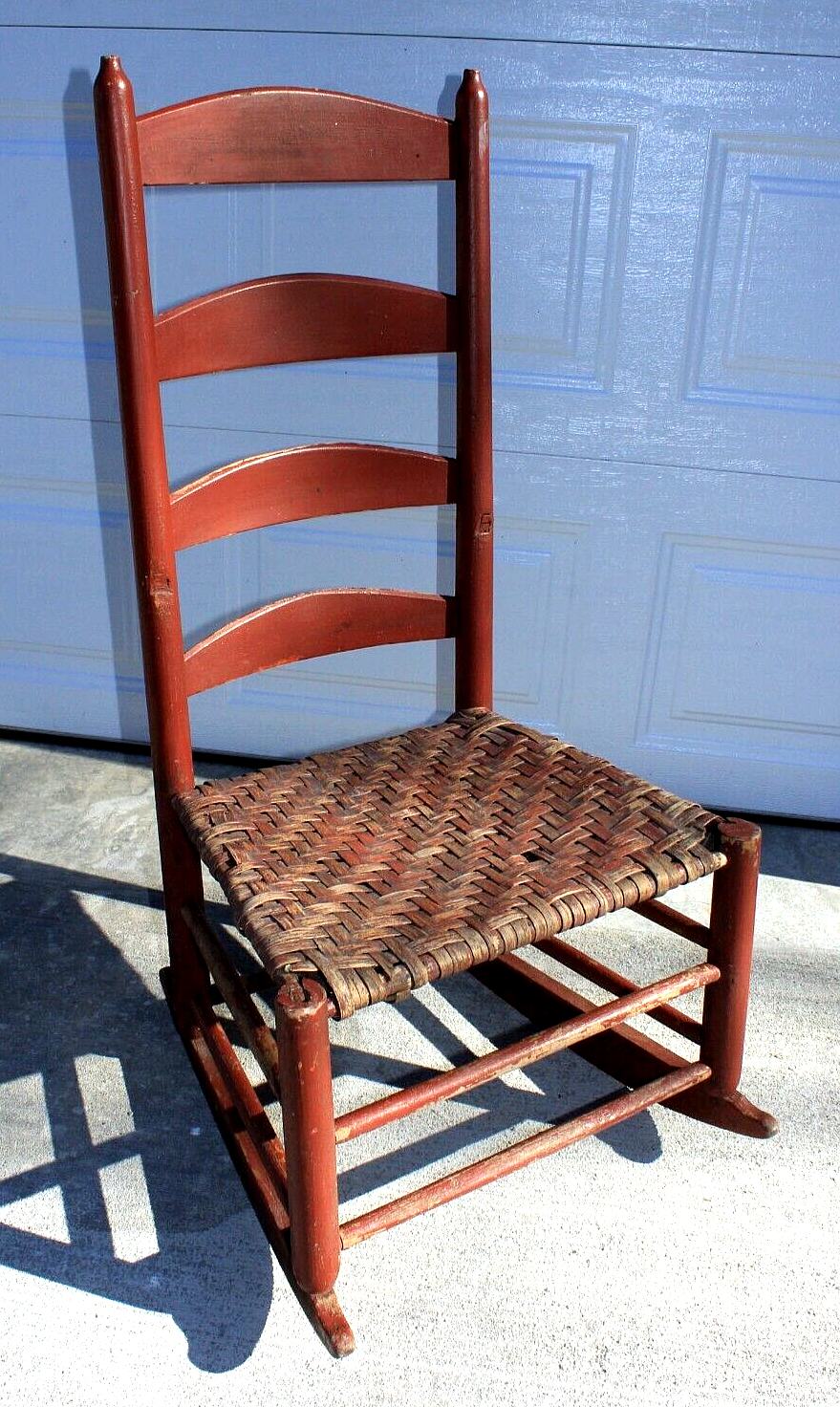
Shaker rocking chairs are characterized by their minimalist design and focus on functionality. They feature ladder-backs, wooden seats, and often have woven seat backs and arms for added comfort. To identify a Shaker rocker, look for clean lines, lack of excessive ornamentation, and the use of traditional joinery techniques.
Victorian Rocking Chair
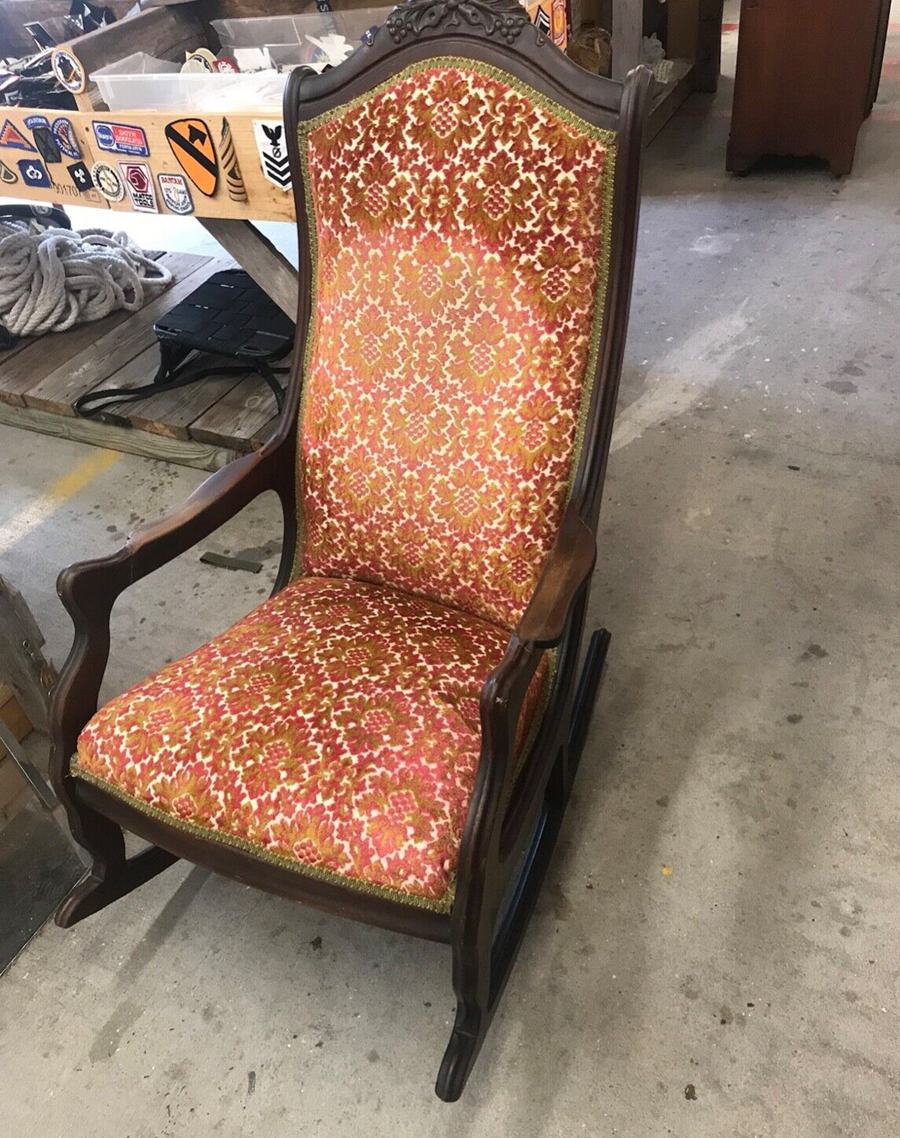
Victorian rocking chairs display intricate, elaborate designs and often feature upholstered seats and backs. These chairs often have carved wooden details, such as floral patterns, scrolls, or claw feet. To identify a Victorian rocker, look for these unique design elements and signs of age-appropriate wear and patina.
Thonet Rocking Chair
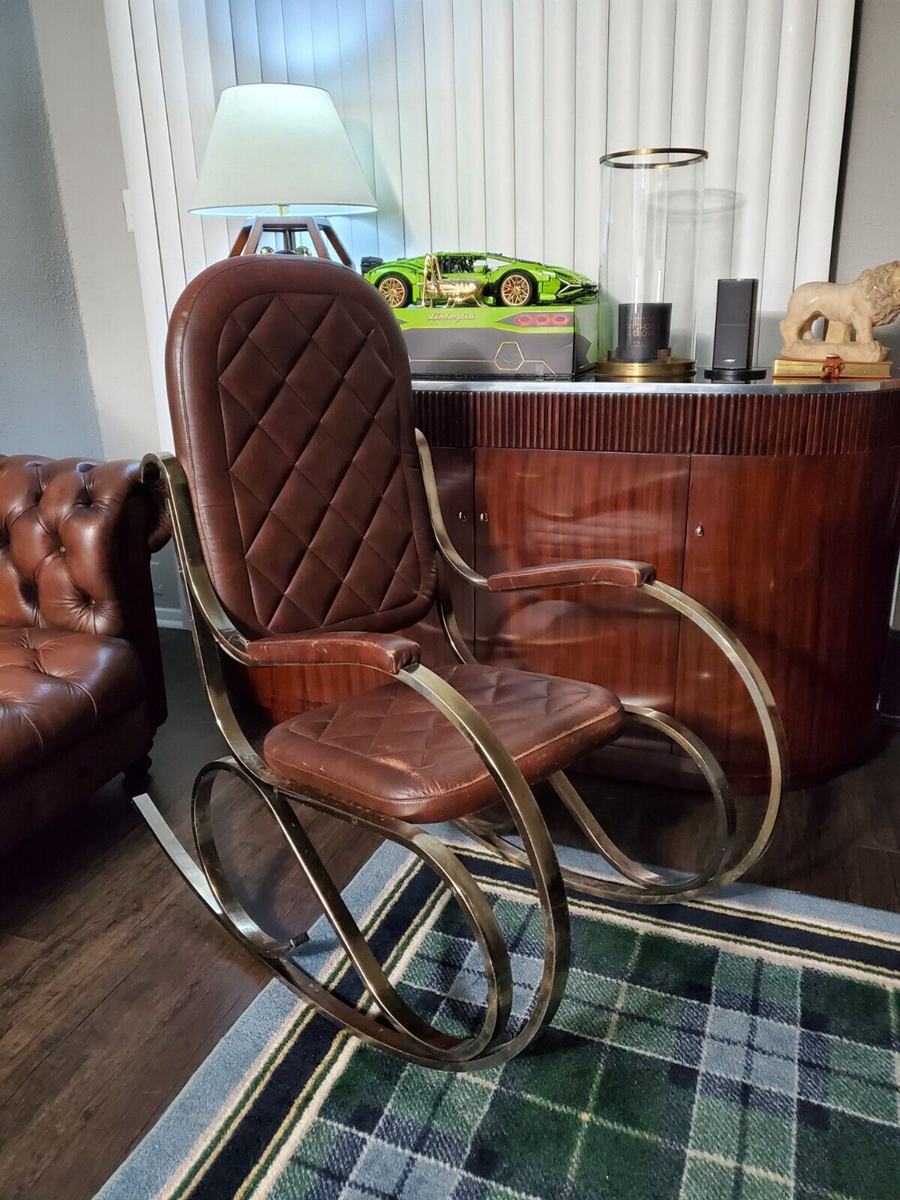
Thonet rocking chairs showcase the art of bentwood furniture and are characterized by their graceful curves and lightweight design. Popularized by Michael Thonet in the mid-19th century, these chairs feature distinctive bentwood frames with woven cane seats and backrests. To identify a Thonet rocker, look for the hallmark curved wood and authentic Thonet markings or labels.
Child’s Rocking Chair
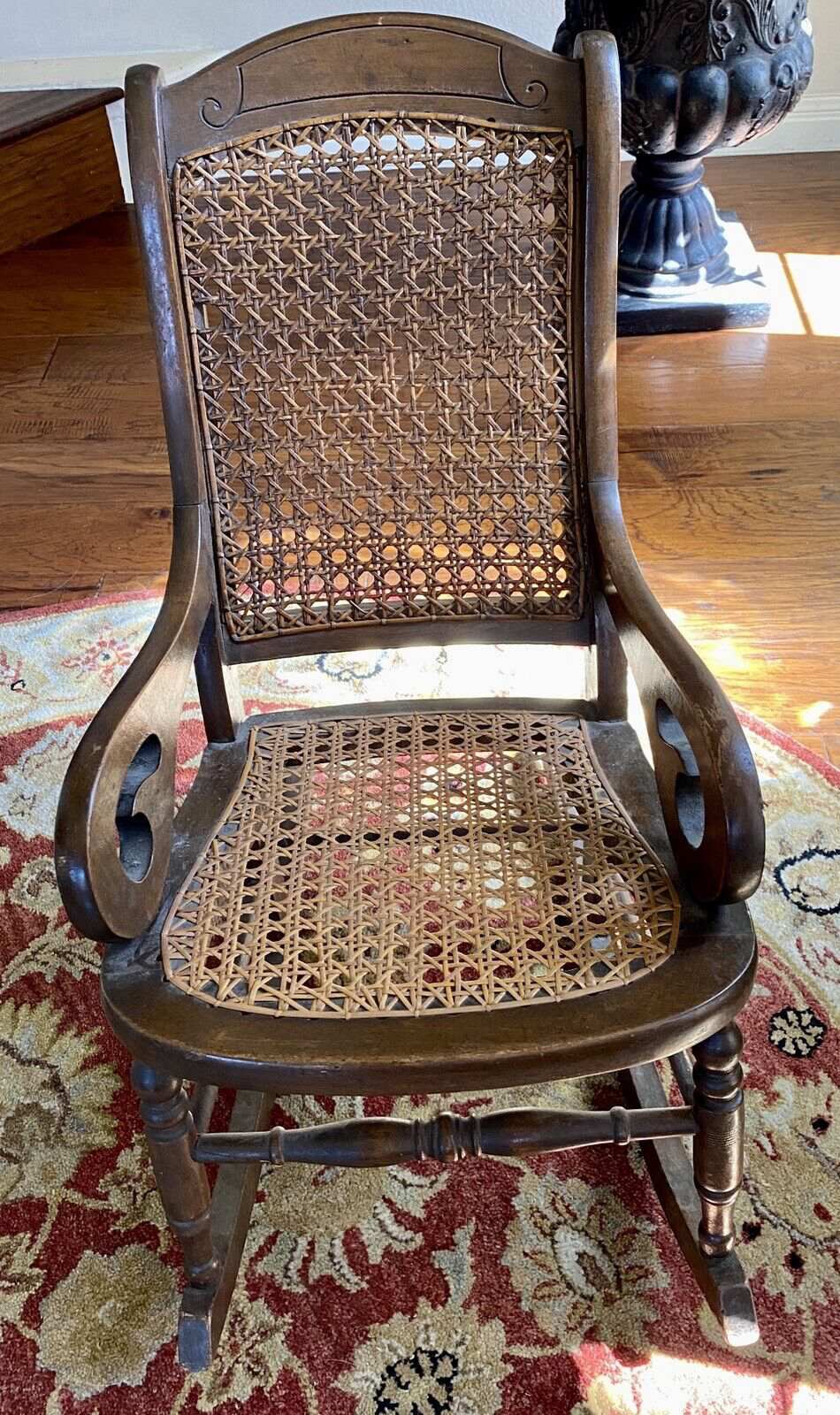
Child’s rocking chairs are smaller versions of traditional rocking chairs, designed specifically for children. These chairs can come in various styles, such as Windsor, Shaker, or Victorian. To identify a genuine antique child’s rocking chair, look for signs of age as well as the scaled-down size appropriate for a child.
Morris Rocking Chair

Morris rocking chairs are known for their adjustable recline and comfortable cushions. They were popular during the Arts and Crafts movement and typically feature wooden frames with detailed carvings or turned spindles. To identify a Morris rocker, look for the distinctive adjustable backrest and other design features consistent with the Arts and Crafts style.
Factors to Identify and Value an Antique Rocking Chair
1. Historical Significance
The historical significance of an antique rocking chair can greatly impact its value. Several factors play a crucial role in determining the worth of a piece, such as age, manufacturer, and origin of materials. In this section, you’ll find a brief guide to identifying and valuing antique rocking chairs based on these factors.
Age
Age is often an essential factor in the value of antique rocking chairs. They are believed to have first entered the market around 1710 in Europe, and as such, older chairs tend to be more valuable. Here is a valuation table based on the age of antique rocking chairs:
| Age of Rocking Chair | Average Valuation |
|---|---|
| 18th Century | $700 – 900 |
| 19th Century | $400 – 600 |
| Early 20th Century | $200 – 400 |
| Mid-20th Century | $100 – 200 |
Manufacturer
The manufacturer can also affect the value, as certain well-known makers are highly sought after by collectors. When identifying a chair, check for the manufacturer’s logo or mark on the underside. Here are some common makers and their average valuations:
| Manufacturer | Average Valuation |
|---|---|
| Hitchcock | $300 – 500 |
| Stickley | $800 – 1200 |
| Thonet | $600 – 800 |
| Shaker | $700 – 1000 |
Origin of Materials
The type of wood used in the construction of a rocking chair can also be an indicator of its historical significance and value. Native hardwoods were used in chair construction during the 18th to early 19th centuries, while hickory, ash, oak, and beech were popular choices for bent wood parts. Below is a table outlining the average valuation based on the origin of materials used:
| Wood Type | Average Valuation |
|---|---|
| Oak | $400 – 500 |
| Ash | $300 – 400 |
| Mahogany | $700 – 900 |
| Walnut | $600 – 800 |
By considering the age, manufacturer, and origin of materials, you can better determine the historical significance and value of an antique rocking chair. This knowledge will aid you in your buying or selling endeavors and will help you appreciate the rich history and craftsmanship behind these beautiful pieces.
2. Artistic Value
When considering the artistic value of antique rocking chairs, understanding the design style, artist or designer, and the manufacturing process will greatly impact their inherent value. A few key design styles of antique rocking chairs you may encounter are:
- Bentwood Rocker
- Boston Rocker
- Ladderback Rocker
- Windsor Rocking Chair
Here is a brief valuation table for some of these styles:
| Rocking Chair Style | Average Valuation |
|---|---|
| Bentwood Rocker | $300 – $600 |
| Boston Rocker | $200 – $500 |
| Ladderback Rocker | $150 – $400 |
| Windsor Rocking Chair | $250 – $550 |
You will want to be familiar with the specific artist or designer of your rocking chair, as this often has an effect on value. Some rocking chairs have a maker’s mark or manufacturer’s mark that can help you identify the creator, while others may require some research.
In addition to style and maker, the manufacturing process can also influence the artistic value of your antique rocking chair. Early 19th century ladderback and Windsor rocking chairs are often simple in design and sturdy, while late 19th century rocking chairs may feature more elaborate carvings and unique design features.
By understanding the design style, artist or designer, and manufacturing process of your antique rocking chair, you can better assess its artistic value and potential worth.
3. Condition
The condition of your antique rocking chair plays a major role in determining its value. Several factors need to be considered when evaluating the condition of the piece, such as completeness, repair history, and the degree of defects present.
Completeness
Assessing the completeness of your antique rocking chair involves examining if all the original parts and components are intact. Pay close attention to the following elements:
- Spindles
- Arms
- Legs
- Seat
- Backrest
Replacement of any part with non-original materials would decrease the value of the chair.
Repair History
Be aware of the chair’s repair history. Professional and well-done repairs can help maintain the value of the piece, but poorly executed repairs can reduce its worth. Look for evidence of glue, filler, or mismatched wood types that may indicate past repairs.
Degree of Defects
Inspect your antique rocking chair for any defects, such as cracks, splits, woodworm damage, or severe wear on the wood’s surface. The severity and location of these defects can potentially impact the chair’s value.
Based on these factors, you can estimate the average valuation of your antique rocking chair using the table below:
| Antique Rocking Chair’s Condition | Average Valuation |
|---|---|
| Excellent, No Repairs | $1,200 – $1,600 |
| Good, Minor Repairs | $800 – $1,200 |
| Fair, Significant Repairs | $400 – $800 |
| Poor, Major Repairs or Defects | Below $400 |
This table should serve as a reference when assigning a value to your antique rocking chair. Keep in mind that other factors, such as rarity and origin, may also influence its worth.
4. Unique Attributes
When identifying and valuing antique rocking chairs, there are several unique attributes to consider. These include the rarity, signature or marking, and historical background related to historical events of a specific chair.
Rarity
Rarer antique rocking chairs have a higher value due to their scarcity. Factors that contribute to a chair’s rarity include the uniqueness of its design, limited production numbers, or being crafted by a well-known artisan.
Signature or Marking
Finding a manufacturer’s mark or signature on an antique rocking chair can be challenging but greatly impacts the chair’s value. Often, these marks can be found on the chair’s underside, back, or hidden within the construction. Locating a specific artisan or manufacturer signature adds credibility to the chair’s authenticity and can increase its worth.
Historical Background
The historical background and connection to significant events can also affect an antique rocking chair’s value. Chairs that have a known provenance or those related to famous figures may hold higher importance and, therefore, have a higher valuation.
Valuation Table for Unique Attributes
| Unique Attribute | Average Valuation |
|---|---|
| High Rarity | $1,500 – 2,000 |
| Known Signature/Marking | $1,000 – 1,500 |
| Historical Background | $750 – 1,000 |
| Combination of Two Attributes | $2,000 – 2,500 |
| Combination of All Three Attributes | $2,500 – 3,500 |
Keep in mind that these valuations are approximate and can vary significantly based on the specific chair, its condition, and the market demand. Consulting with an antique expert is always recommended when trying to accurately determine an antique rocking chair’s value.
5. Market Demand
The market demand for antique rocking chairs depends on various factors, including current trends in the antique market and the preference for specific designs and manufacturers.
Trends and Preferences
You should pay attention to the current trends in the antique furniture market. Demand tends to fluctuate over time, and what might have been popular a few years back may not be as desirable today. By staying informed about prevailing trends, you can keep the pulse of demand for antique rocking chairs.
Popular Designs and Manufacturers
Certain designs and manufacturers are consistently in demand. Some of these classic rocking chair styles include:
- Bentwood Rocker
- Boston Rocker
- Folding Rocking Chair
- Gungstol Rocker
- Jenny Lind Children’s Locker
- Ladderback Rocker
- Mission Style Rocker
- Platform Rocker
- Pressed Back Rocker
- Swing Rocker
- Wicker Rocking Chair
- Windsor Rocking Chair
It’s crucial to research the manufacturers of these styles to ensure the authenticity of these antique rocking chairs. Valuable manufacturers include Plail Brothers, L & J.G. Stickley, and those that produced ladder back and Windsor rocking chairs in the 18th to early 19th century.
Collector Interests and Demands
Finally, the value of antique rocking chairs is influenced by the interests and demands of collectors. Understanding what collectors are looking for helps you focus on collecting and selling the rocking chairs that are likely to be the most sought-after.
Valuation Table
Accounting for the factors mentioned above, here’s a valuation table for antique rocking chairs:
| Rocking Chair Style | Average Valuation |
|---|---|
| Early 1800s (Carved Arms, Spiral Legs, Curvilinear Shapes) | $500 – 800 |
| Late 1850s (Pad Armrests, Slated Backs, Thick Wood Sections) | $450 – 650 |
| Bentwood Rocker | $300 – 700 |
| L & J.G. Stickley Rocker | $750 – 4,000 |
| Plail Brothers Barrel Rocker | $1,500 – 2,500 |
| 18th-19th Century Ladder back/Windsor Rocker | $800 – 1,500 |
By understanding the factors contributing to market demand, the preferences for styles and manufacturers, and the interests of collectors, you can more accurately determine the value of antique rocking chairs and navigate the market with confidence.
6. Appearance and Features
As you evaluate an antique rocking chair, pay attention to the color, wood type, shape, design characteristics, and size of the chair. Let’s go through each of these factors in more detail.
Color and Wood Type
The type of wood used in an antique rocking chair can influence its value. Common wood types include:
- Walnut
- Mahogany
- Rosewood
- Oak
- Maple
- Teak
- Birch
Examine the wood finish, as it can also impact the chair’s value. Chairs with original finishes or a warm patina are typically more valuable.
Shape and Design Characteristics
Different styles of antique rocking chairs have distinct design features, such as hand-carved legs or unique armrests. Here’s a summary of common design characteristics and their average valuations:
| Design Feature | Average Valuation |
|---|---|
| Carved arms, spiral legs, curvilinear | $500 – $800 |
| Pad armrests, slated backs, thick wood | $500 – $1,000 |
| Hand-turned or carved wood spindles | $100 – $3,500 |
| Asymmetrical spindles with wood finish | $100 – $1,500 |
| Metal spindles with patina, aged look | $300 – $600 |
Size and Proportion
The size and proportion of an antique rocking chair can affect its value. Larger chairs with more intricate designs may be more valuable than smaller ones. However, it’s essential to consider other features such as wood type, condition, and rarity when making an assessment.
Remember to evaluate your antique rocking chair thoroughly, considering all these factors to determine its actual value. This will help you make a more informed decision when purchasing, selling, or preserving an antique rocking chair.
Final Thoughts
Taking into consideration various factors while identifying and determining the value of antique rocking chairs can help you make more informed decisions. Whether it’s for collecting, selling, or just appreciating the craftsmanship, being aware of these factors can enhance your experience.
To get a better understanding of your chair’s history:
- Examine the wood type, as it often points to the chair’s origin and time period.
- Look into surface finishes because they offer insight into the level of artisanship involved in creating the chair.
- Check for production marks, which may help identify the specific maker or manufacturer.
- Understand the production process, as handcrafted pieces often hold more value than mass-produced ones.
When evaluating the value of your antique rocking chair:
- Take note of the chair’s joinery features, as earlier methods of construction may denote greater value.
- Consider the upholstery specs, especially if the fabric, padding, and overall condition of the chair are in good shape.
- Inspect the screws, nails, nuts, and bolts to determine their age, as older hardware may indicate a more valuable chair.
By keeping these points in mind while exploring the world of antique rocking chairs, you will not only sharpen your understanding of their intricate designs but also ensure that you make educated estimations of their value. This will ultimately lead you to make smarter choices, be it in purchasing or simply appreciating these beautiful pieces of history.
FAQ
Q: How do I identify the wood type on my antique rocking chair?
A: To identify the wood type, inspect the grain pattern, color, and weight. Compare these characteristics to common wood types used in antique rocking chairs, such as walnut, oak, cherry, or mahogany. Knowing the wood type can help you determine the chair’s age and value.
Q: How can I tell if my rocking chair’s surface finish is original or restored?
A: Original finishes on antique rocking chairs tend to show signs of aging, such as crazing or minor cracks. They may also have a patina, which gives the surface an aged appearance. Restored finishes are usually smoother and shinier. If you are unsure, consult with an antique expert for their opinion.
Q: What should I look for in terms of production marks?
A: Antique rocking chairs may have distinguishing marks or labels from the manufacturer, such as brand names, logos, or patent dates. These marks can be found on wooden parts of the chair or on the metal hardware. Keep in mind that production marks can sometimes be faked, so it’s essential to verify the authenticity of the marks.
Q: What should I consider when examining the upholstery?
A: The upholstery materials and techniques used can give you clues about the chair’s age and style. For example, antique rocking chairs often have horsehair or cotton stuffing, while more recent chairs use foam. Additionally, check for hand-stitched seams and fabric types indicative of the chair’s era.
Q: How do I determine the value of my antique rocking chair?
A: Consider factors such as condition, age, rarity, and craftsmanship to determine the chair’s value. Analyze the information you’ve gathered about the chair, and compare it to similar rocking chairs in the market. You can also consult an antique furniture appraiser for a more accurate assessment. Keep in mind that values can fluctuate based on market trends and demand.
Remember to use this information as a guide and consult with experts to ensure accurate identification and valuation of your antique rocking chair.

